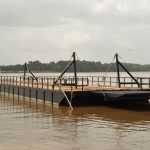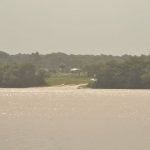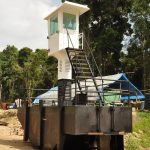Barge crossing for Section Two of Amaila Road complete – installation held up by low water level in Essequibo River
By Tajeram Mohabir, March 20, 2015, Source

THE $120 million roll on/roll off barge with propulsion units and controls to be connected at the end of the access road of Section Two of the Amaila Falls Hydro Power Project to facilitate crossing of the Essequibo River has been completed. But its installation has been held up due to the low water level in the river. Public Works Minister Robeson Benn on a visit to the site on Wednesday said the low water level has prevented the contractor Infab to fit the propulsion units to the barge.
The Ministry of Public Works and Infab are deciding whether to wait until the water rises or dredge the river. The latter option would cost some $11 million.
“By the time the water comes, we will want the thing to be in operation so we will have to decide whether we will put it on now or wait later. We have to find a simple solution or we wait,” Minister Benn said.
But he noted that the ministry wants the barge to be installed before the May/June rains. Currently, a makeshift barge is being used to facilitate crossing of the Essequibo Riverat the end of Section Two of the Amaila Falls Road.
The minister said the barge will be the prototype for the Kuribrong River, noting that the design adopted will save quite a sum of money with respect to the Kuribrong crossing.
The barge crossing is built to withstand weight of up to 120 tonnes
Ministry of Public Works Engineer Walter Willis said the roll on/roll off feature was not originally planned for the barge, but was added after some investigation, to enable easy manoeuvring.
Crossing at the barge will lead to the Butakari Landing, Section Three of the Amaila Falls Access Road. At the end of Section Six is the meandering Kuribrong River and the end of Section Seven is another section of the Kuribrong River, leading to Amaila Falls.
OPTIMISM
President Donald Ramotar in early February last year said the Amaila Falls Hydropower Project remains the number one priority of his administration, and he remains hopeful that the mega-project would become a reality
The President who was at the time speaking at the commissioning of the Guyana Power and Light (GPL) power station at Vreed-en-Hoop, West Coast Demerara, said efforts are being made to restart work on the transformative project before year-end.
A lot of work has already been done on the project, and President Ramotar pointed out that Norway had already transferred US$80 million to the Inter-American Development Bank (IDB) to get the project back on stream.
“We have already identified another company to step into the shoes of Black Stone and Sithe Global. We are working feverishly to conclude this arrangement, so that, hopefully, we can start construction very soon,” President Ramotar had said.
He pointed out that through the Low Carbon Development Strategy (LCDS) agreement with Norway, some US$150 million of the US$250 million has already been disbursed to Guyana, contending that “We have the resources to go in that direction [restarting work on the Amaila Project].”
VOTED DOWN
The Amaila Falls Hydropower Project was voted down by the Alliance For Change (AFC) and the A Partnership for National Unity (APNU) during the 10th Parliament.
It is one of the flagship projects of the LCDS. Once completed, it is expected to remove 92 per cent of Guyana’s energy-related greenhouse gas emissions, deliver energy security for Guyana, provide cheaper energy for citizens and businesses, and promote the achievement of the Millennium Development Goals in Guyana.

Ready for installation: The barge built by Infab but cannot be installed due to the current water level in the Essequibo River
The project that was voted down was the largest foreign investment and infrastructural project in the history of Guyana. It was aimed at providing a stable and dependable source of energy that will bolster Guyana’s overall economic growth while reducing the country’s dependence on fossil fuel.
The project was geared to reduce Guyana Power and Light’s (GPL) cost of electricity generation, saving an estimated US$3.5 billion for consumers over contract term.
In financial terms, the project would have allowed Guyana to avoid importing approximately US$200 million in fuel per annum, while costing GPL approximately US$100 million per annum on average.
Based on estimates, the project would have allowed GPL to reduce its generation cost from close to US 20 cents per kwh, to approximately US 11 cents per kwh.
The project was developed as a Public-Private Partnership, with the private sector leading in its development. Government was a minority investor, with the goal of seeking to lower the cost of electricity.
The life of the 165 MW hydro project was estimated to be over 100 years and would have been fully financed and paid off over a 20-year period. -- By Tajeram Mohabir


